The images in the following program are very sensitive and may be as disturbing to viewers as they were to us. However, we have to show the truth of animal cruelty.
HOST:
Caring viewers, welcome to Animal World: Our Co-Inhabitants. On this episode of the Stop Animal Cruelty series we will look at how the relationship between humankind and its best friend the noble dog is being betrayed. Our focus is a highly troubling topic, the dog meat trade in Asia. The newspaper Animal People estimates that each year in Asia up to 16 million dogs are brutally tortured and slaughtered for human consumption.
Dogs are obtained for the trade from numerous sources. Regardless of the source, however, the tremendous fear and panic these sensitive animal co-inhabitants feel at being caught and killed for their flesh is the same.
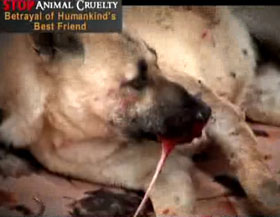 Many dogs used in the meat trade are homeless and taken from the streets. Once captured, they may have their muzzles tightly bound with plastic string or alternatively a tin can may be placed over their snouts to stop them from biting or barking. This abusive practice can prevent dogs from being able to pant, the primary way dogs cool their bodies. Thus they may subsequently die of heat stroke. If the muzzle is bound too tightly the canine co-inhabitant may not be able to breathe, causing asphyxiation and death. Also, the dogs may have their front legs dislocated and tied behind their backs so that they cannot move about, causing extreme agony and pain to these gentle and loyal beings.
Many dogs used in the meat trade are homeless and taken from the streets. Once captured, they may have their muzzles tightly bound with plastic string or alternatively a tin can may be placed over their snouts to stop them from biting or barking. This abusive practice can prevent dogs from being able to pant, the primary way dogs cool their bodies. Thus they may subsequently die of heat stroke. If the muzzle is bound too tightly the canine co-inhabitant may not be able to breathe, causing asphyxiation and death. Also, the dogs may have their front legs dislocated and tied behind their backs so that they cannot move about, causing extreme agony and pain to these gentle and loyal beings.
Other heartless methods employed to supply dogs for this cruel, inhumane business include theft of people’s pets by gangs, which typically search for larger dogs that have more flesh and are thus more profitable. Some dogs seen at meat markets still have their collars on before they are slaughtered. Some shelters that are supposed to protect and re-home abandoned and stray dogs actually sell the animals to butchers in order to save or make money.
There have also been cases of individuals advertising in pet magazines offering to find new homes for dogs if their caregivers are no longer able to care for them. These people then go on to sell the canines to meat traders. Female dogs from puppy mills that can no longer produce litters and puppies that are believed to be unfit for sale may also end up being sold for meat.
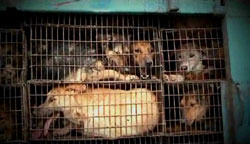 Shockingly, many dogs are also raised specifically for meat production. Some such businesses are small backyard operations, but dogs are now commonly raised on factory farms for the purpose of human consumption. At these bloody sites the dogs may be imprisoned six to a cage, with some cages being so small that the animals lack enough room to move their limbs and so they develop painful hernias.
Shockingly, many dogs are also raised specifically for meat production. Some such businesses are small backyard operations, but dogs are now commonly raised on factory farms for the purpose of human consumption. At these bloody sites the dogs may be imprisoned six to a cage, with some cages being so small that the animals lack enough room to move their limbs and so they develop painful hernias.
Infections such as parvo virus, canine distemper and leptospirosis are commonplace among farm-raised dogs. Confined to cages from which they are never let out, many of the dogs develop severe psychological problems, which are reflected in repetitive movements and scratching on cages.
The animals develop deformed limbs as they lack a surface to walk on. The dogs also suffer from exposure to all types of weather conditions without proper protection. In the cold they freeze and in the heat they may suffer from heat stroke. Typically, farm-raised dogs are given very little water and are also fed left-over, rotting human food as this is believed to improve the flavor of the dog’s flesh.
The transportation and handling of these dogs causes further suffering as they are literally squashed into cages. Up to 2,000 animals may be stacked on top of one another in a single truck, and as a result many die from suffocation. They are shipped for days with no food or water in all types of weather and with no regard for their welfare. To learn more about the unfeeling, callous transport of these canines, we spoke with Ms. Jill Robinson of the Animals Asia Foundation, which is based in Hong Kong and is devoted to the protection and welfare of animals in the region.
Jill Robinson:
It’s a truly horrific industry. The dogs are coming from all across the country in both China and in Vietnam. In China, they are generally raised by people who have other domestic animals for the farming industry. They are then collected by a middle man and then trucked, usually from the north of China way down to the south of the country. In journeys by road they endure the most horrendous cruelty for three or four days overnight, overland. These places where they are offloaded are called “live animal markets” in China.
The animals are treated in such a disgusting condition. They are offloaded screaming and crying with the cages stacked so high on the trucks that they are just literally thrown from the top of the truck and they are smashed onto the concrete below.
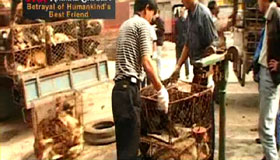 So if the animals, the dogs or the cats, have their paws through the cage wire, they will be smashed onto the concrete as well. Many of the animals are also pregnant. You know, mother dogs and cats are having babies which they abort during such horrible conditions. Then they lie there in these cages in the heat of the sun and the cold in the winter, again, for several days as people start to buy them and then transport them to other areas of the country.
So if the animals, the dogs or the cats, have their paws through the cage wire, they will be smashed onto the concrete as well. Many of the animals are also pregnant. You know, mother dogs and cats are having babies which they abort during such horrible conditions. Then they lie there in these cages in the heat of the sun and the cold in the winter, again, for several days as people start to buy them and then transport them to other areas of the country.
HOST:
When we return we will continue our program on the inhumane treatment of dogs in the meat trade. You are watching Supreme Master Television.
HOST:
Welcome back to Animal World: Our Co-Inhabitants where we have been discussing the appalling dog meat trade in Asia. Jill Robinson of the Animals Asia Foundation reveals more about the dreadful shipping of dogs to be purchased for meat.
Jill Robinson:
When we rescued the dogs in Sichuan Province and we were taking the cages off of the trucks, they were just screaming and crying in terror. They were defecating. They were urinating. They were vomiting. They were just out of their heads with fear. They absolutely were. This is what goes on in the markets all the time. They are grabbed around the throat with these metal tongs and slung out onto the floor, and then bludgeoned over their heads with these sort of baseball bat type things, or slit across the throat. And it’s just unimaginable, where we are now, where the whole world is developing a more compassionate nature, how we can actually physically be so violent to sentient species, warm blooded mammals that feel the same pain and feel the same anxiety as we do.
HOST:
The methods used to butcher and slaughter the animals are purposely designed to prolong and intensify the canine co-inhabitants’ suffering due to the false and sickening belief that the more pain and suffering the dog feels when their life ends, the better their flesh will taste. It is for this reason that the dogs are butchered alive while fully conscious.
Some are brutally stabbed in the neck or groin. Others are electrocuted while hung. These innocent canines may even be horrifically set on fire with a propane blow torch in order kill them and remove their fur at the same time. The burning is done slowly in order to cause the maximum amount of agony and torture.
Jill Robinson:
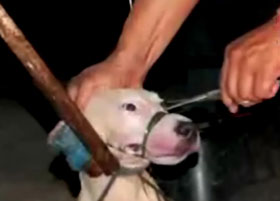 The method of slaughter is beyond belief. We have seen them stabbed through the jugular, down into the heart where they are bled out. We have seen them bashed on the head and on the snout, falling into unconsciousness and then coming into consciousness again during the process. We’ve seen them thrown into vats of boiling water, still conscious, where they are struggling to get out of the heat and the horrors that face them. All this is in front of the other dogs that are waiting to be killed equally cruelly.
The method of slaughter is beyond belief. We have seen them stabbed through the jugular, down into the heart where they are bled out. We have seen them bashed on the head and on the snout, falling into unconsciousness and then coming into consciousness again during the process. We’ve seen them thrown into vats of boiling water, still conscious, where they are struggling to get out of the heat and the horrors that face them. All this is in front of the other dogs that are waiting to be killed equally cruelly.
Jill Robinson:
You see the dogs in the cages looking at the other dogs and cats that are being slaughtered in front of their eyes and there’s no doubt in my mind that they know that it’s their turn next. Sometimes you see them just gently whimpering in the cages and sometimes they are just screaming and crying.
So, the whole picture of this disgusting industry is just so inherently cruel mentally and physically from start to finish.
HOST:
Dogs also may be bled to death so their blood can be collected and sold, and countless gentle canines are savagely skinned alive each year to provide fur for the clothing industry. Much of this fur ends up on the international market as trim on jackets and gloves.
Jill Robinson:
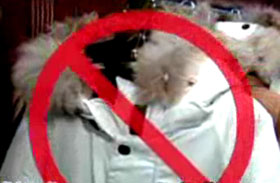
Where dogs are slaughtered, very often their fur is used as a byproduct. I think that this causes for a very significant warning to anyone looking at this film. Please if you are in any doubt if the fur is real or fake, just don’t buy it. Because inevitably it will be real fur. It is dyed today in such bright, lurid colors like bright pink, and bright orange and bright blue, you couldn’t even think that it came from an animal, let alone a dog.
But it absolutely does. I urge people please just drop all fur from your clothing.
HOST:
What can we do to stop this unbelievable brutality to humankind’s best friend? For starters, please never buy or consume dog meat and tell your friends and family to avoid it as well. Also please remember that dogs are not the only animals tortured, abused and killed for food, as all meat comes from intelligent, loving sentient beings.
Jill Robinson:
I would ask, just always take that opportunity to find out what you’re putting into your bodies. We should not only stop at dogs and cats, but we should stop at all animals. A vegetarian-based diet is much, much healthier for our bodies.
Jill Robinson:
I think the more people now that adopt a vegetarian philosophy, the more not only our planet can be saved but our bodies can be saved as well. There is so much incidence now of cancer as a result of a meat-based diet. There is so much suffering and so much disease out there as well. I think it’s inherent in all of us to look at the sort of food that we’re eating and make a conscious decision to save our planet.
HOST:
We would like to express our great appreciation to Ms. Jill Robinson and the Animals Asia Foundation for their kind heartedness and dedication to protecting the wonderful dogs and other beautiful animals that share our planetary home.
For more details on the Animals Asia Foundation
Please visit www.animalsasia.org

